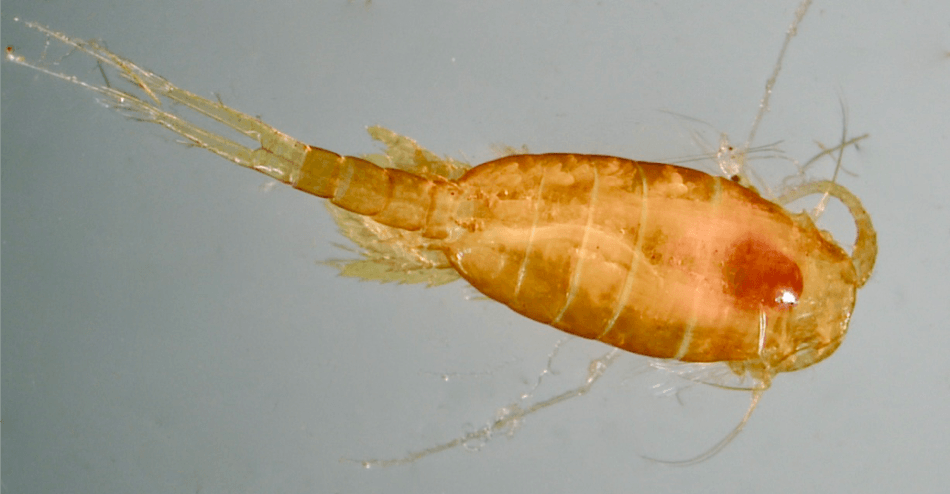Dec 20 2018
According to the findings of oceanographers at The University of Rhode Island, even slight levels of ocean oxygen loss, or deoxygenation, have significant impact on tiny marine organisms known as zooplankton.
 This is Lucicutia hulsemannae, a copepod that stays at the Lower Oxycline of the Oxygen Minimum Zone (OMZ). The organism is remarkably tolerant of extremely low oxygen levels, but very sensitive to small changes in those levels. (Image credit: Photo by Dawn Outram)
This is Lucicutia hulsemannae, a copepod that stays at the Lower Oxycline of the Oxygen Minimum Zone (OMZ). The organism is remarkably tolerant of extremely low oxygen levels, but very sensitive to small changes in those levels. (Image credit: Photo by Dawn Outram)
Zooplanktons are vital components of the food web in the expanse of deep, open ocean known as the midwater. Within this segment of ocean underneath the surface and above the seafloor lies wide regions of very low oxygen known as the oxygen minimum zones (OMZs). Unlike coastal “dead zones” where there are possibilities for sudden drop in oxygen levels which can kill marine life not accustomed to such conditions, zooplankton in OMZs are uniquely adapted to survive where other organisms—particularly predators—cannot. However, OMZs are expanding because of climate change, and even minor changes to the low oxygen levels can move zooplankton beyond their extraordinary physiological boundaries.
Although the animals in the ocean’s oxygen minimum zone have adapted over millions of years to the very low oxygen of this extreme and widespread midwater habitat, they are living at the very limits of their physiological capability. Our research shows that they are sensitive to very small changes in oxygen, and decrease in abundance when oxygen gets just a little bit lower.
Karen Wishner, Professor of oceanography, URI’s Graduate School of Oceanography.
The research team, who published their findings in Science Advances this week, found more natural variability in oxygen levels in the OMZ than thought before. This directly affects the distribution of several types of zooplankton since, as the team learned, the organisms react to a less than 1% reduction in oxygen levels.
Although zooplankton have had millions of years to get accustomed to conditions in the OMZ, these low oxygen zones may expand quickly as a result of climate change, causing major unforeseen changes to midwater ecosystems. For instance, an expansion of the OMZ into shallower waters may increase the vulnerability of zooplankton to predators such as fish. If this results in a fall in the zooplankton population, it will have impacts all the way up the food chain.
Further loss of oxygen in ocean waters is predicted in the future as a result of global warming, and these animals may be unable to adapt and persist. They are important components of the food web of oceanic ecosystems, and their loss could potentially impact top predators, including whales and commercially important fisheries.
Karen Wishner, Professor of oceanography, URI’s Graduate School of Oceanography.
Wishner and her teammates, which includes GSO professor Chris Roman and GSO marine research specialist Dawn Outram, gathered their data off the Pacific coast of Mexico in January and February 2017. The Chief Scientist of the cruise was Brad Seibel who was a former professor in the College of the Environment and Life Sciences when the project started and presently with the University of South Florida College of Marine Science. Overnight, Roman’s “wire flyer,” an ocean instrument intended to capture oxygen and other measurements because it quickly oscillates up and down in the water column, was towed from the research vessel Sikuliaq for 50 km. In the day, the vessel traced the same path and obtained samples of many different types of zooplankton using a high-tech sampling net known as a MOCNESS.
The study was funded mainly by the National Science Foundation’s Division of Ocean Sciences. One URI undergraduate (Danielle Moore) and a Summer Undergraduate Research Fellowship in Oceanography (SURFO, URI’s NSF-funded Research Experience for Undergraduates program) student (Shannon Riley from Oregon State University) took part in the study.